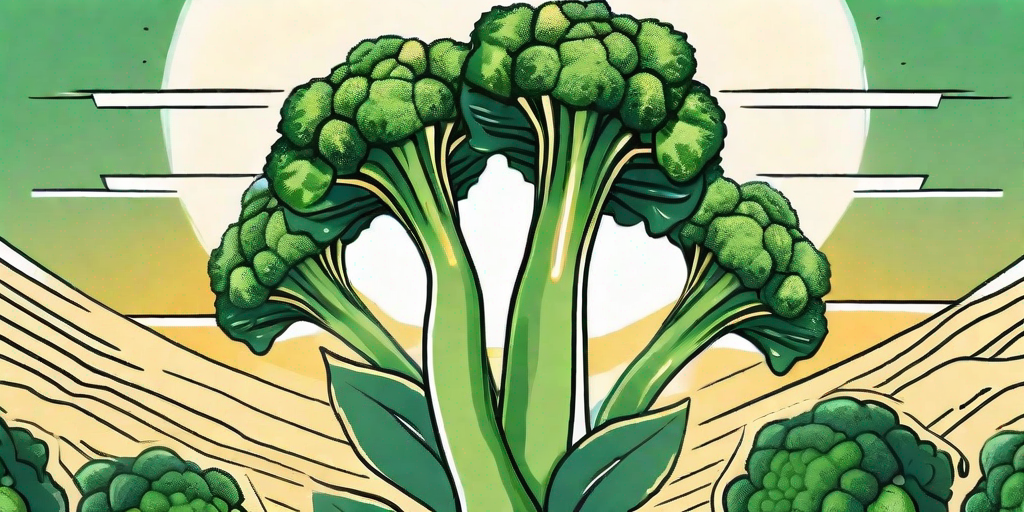
Ah, the humble broccoli. Often the bane of children's dinner plates, yet a superhero in the world of nutrition. But we're not here to discuss the merits of this green powerhouse. No, we're here to talk about the joy of growing your own broccoli and the blissful moment of harvesting it. So, buckle up, green thumbs, it's time to dive into the world of homegrown broccoli.
The Basics of Broccoli
Before we get to the juicy part (or should we say, the crunchy part?), let's cover some broccoli basics. Broccoli is a member of the Brassica family, which includes other favourites like cabbage, kale, and Brussels sprouts. It's a cool-season crop, which means it prefers to grow in cooler weather. So, if you're living in a tropical paradise, you might want to reconsider your broccoli dreams.
Broccoli plants are quite the sight, with their large, blue-green leaves and thick stalks topped with a head of green florets. They're not only delicious but also quite attractive, adding a touch of greenery to your garden. Plus, they're packed with vitamins A and C, as well as dietary fibre, so they're a great addition to your diet.
Types of Broccoli
There are several types of broccoli you can grow in your garden. The most common is the Calabrese broccoli, which is what you usually find in your local supermarket. It has large, dense heads and is named after the Italian province of Calabria, where it originated.
Then there's the Sprouting broccoli, which has smaller heads and lots of shoots. It's a bit more time-consuming to harvest because of all the shoots, but it's well worth the effort. Finally, there's Romanesco broccoli, which is more of a visual treat with its fractal patterns and chartreuse colour. It's not as commonly grown, but if you're up for a challenge, it's definitely worth a try.
Planting Your Broccoli
Now that we've covered the basics, let's get down to business. Planting broccoli isn't rocket science, but it does require some planning. You'll want to start your seeds indoors about 4-6 weeks before the last expected spring frost. Once the seedlings are about 2-3 inches tall, they can be transplanted outdoors.
Broccoli prefers full sun, but it can tolerate partial shade. The soil should be well-drained and rich in organic matter. A pH between 6.0 and 7.0 is ideal. If your soil is on the acidic side, you can add some lime to raise the pH. On the other hand, if it's too alkaline, you can add some sulphur to lower the pH.
Spacing and Watering
When it comes to spacing, broccoli plants need room to grow. You'll want to space them about 18-24 inches apart, with about 36 inches between rows. This will give them plenty of room to spread out and grow.
As for watering, broccoli likes a steady supply of moisture. You'll want to water them deeply, about 1-1.5 inches per week. A good layer of mulch can help retain moisture and keep the weeds at bay.
The Moment of Truth: Harvesting Your Broccoli
Now, the moment you've been waiting for: the harvest. After all your hard work, it's finally time to reap the fruits (or should we say, vegetables) of your labour. But how do you know when your broccoli is ready to harvest?
Well, you'll want to look at the head of the broccoli. It should be firm and tight, with a deep green colour. If the florets start to separate and turn yellow, you've waited too long. The size of the head can vary depending on the variety, but generally, a diameter of 4-7 inches is a good sign.
How to Harvest
To harvest your broccoli, simply cut the head off the plant with a sharp knife. Make sure to leave a few inches of the stalk attached to the head. You can also harvest the smaller side shoots that develop after the main head is harvested. These can be harvested for several weeks, or until the plants start to flower.
Once harvested, broccoli should be eaten as soon as possible for the best taste and nutritional value. However, it can be stored in the refrigerator for up to a week. You can also blanch and freeze it for longer storage.
Common Broccoli Growing Problems and Solutions
Like any plant, broccoli can have its share of problems. But don't worry, we've got solutions for the most common issues.
Caterpillars
Broccoli is a favourite snack for caterpillars, especially the cabbage looper and the imported cabbageworm. These pests can be controlled with Bacillus thuringiensis (Bt), a natural bacterium that kills caterpillars.
Clubroot
Clubroot is a soil-borne disease that causes the roots to swell and deform. The best way to prevent clubroot is to rotate your crops and avoid planting broccoli in the same spot for at least four years.
Black Rot
Black rot is a bacterial disease that causes yellow, V-shaped lesions on the leaves. To prevent black rot, make sure to space your plants properly for good air circulation and avoid overhead watering.
FAQs
Can I grow broccoli in containers?
Yes, you can! Broccoli can be grown in containers that are at least 12 inches deep. Just make sure the container has good drainage and is filled with a high-quality potting mix.
Can I grow broccoli from scraps?
While it's possible to grow broccoli from scraps, it's not very practical. The plant will produce leaves, but it's unlikely to produce a full-sized head of broccoli.
Why is my broccoli turning yellow?
If your broccoli is turning yellow, it's likely because it's overripe. Try to harvest your broccoli when the head is still green and the buds are tightly closed.
Conclusion
And there you have it, folks! Everything you need to know about growing and harvesting your own broccoli. So, what are you waiting for? Get out there and start planting! And remember, the only thing better than eating fresh, homegrown broccoli is the satisfaction of knowing you grew it yourself.











